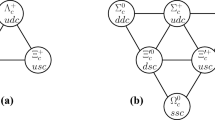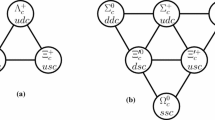Abstract
We analyze heavy-to-light baryonic form factors at large recoil and derive the scaling behavior of these form factors in the heavy quark limit. It is shown that only one universal form factor is needed to parameterize Λ b → p and Λ b → Λ matrix elements in the large recoil limit of light baryons, while hadronic matrix elements of Λ b → Σ transition vanish in the large energy limit of Σ baryon due to the space-time parity symmetry. The scaling law of the soft form factor η(P ′ ·v), P ′ and v being the momentum of nucleon and the velocity of Λ b baryon, responsible for Λ b → p transitions is also derived using the nucleon distribution amplitudes in leading conformal spin. In particular, we verify that this scaling behavior is in full agreement with that from light-cone sum rule approach in the heavy-quark limit. With these form factors, we further investigate the Λ baryon polarization asymmetry α in Λ b → Λγ and the forward-backward asymmetry A F B in Λ b → Λl + l −. Both two observables (α and A F B ) are independent of hadronic form factors in leading power of 1/m b and in leading order of αs. We also extend the analysis of hadronic matrix elements for Ω b → Ω transitions to rare Ω b → Ω γ and Ω b → Ω l + l − decays and find that radiative Ω b → Ω γ decay is probably the most promising FCNC b → s radiative baryonic decay channel. In addition, it is interesting to notice that the zero-point of forward-backward asymmetry of Ω b → Ω l + l − is the same as the one for Λ b → Λl + l − to leading order accuracy provided that the form factors \( {\overline \zeta_{\text{i}}}\left( {i = { 3},{4},{5 }} \right) \) are numerically as small as indicated from the quark model.
Similar content being viewed by others
References
N. Isgur and M.B. Wise, Heavy baryon weak form-factors, Nucl. Phys. B 348 (1991) 276 [INSPIRE].
T. Mannel, W. Roberts and Z. Ryzak, Baryons in the heavy quark effective theory, Nucl. Phys. B 355 (1991) 38 [INSPIRE].
A.F. Falk and M.E. Peskin, Production, decay and polarization of excited heavy hadrons, Phys. Rev. D 49 (1994) 3320 [hep-ph/9308241] [INSPIRE].
M.J. Dugan and B. Grinstein, QCD basis for factorization in decays of heavy mesons, Phys. Lett. B 255 (1991) 583 [INSPIRE].
J. Charles, A. Le Yaouanc, L. Oliver, O. Pene and J. Raynal, Heavy to light form-factors in the heavy mass to large energy limit of QCD, Phys. Rev. D 60 (1999) 014001 [hep-ph/9812358] [INSPIRE].
C.W. Bauer, S. Fleming, D. Pirjol and I.W. Stewart, An effective field theory for collinear and soft gluons: Heavy to light decays, Phys. Rev. D 63 (2001) 114020 [hep-ph/0011336] [INSPIRE].
M. Beneke, A. Chapovsky, M. Diehl and T. Feldmann, Soft collinear effective theory and heavy to light currents beyond leading power, Nucl. Phys. B 643 (2002) 431 [hep-ph/0206152] [INSPIRE].
M. Beneke and T. Feldmann, Factorization of heavy to light form-factors in soft collinear effective theory, Nucl. Phys. B 685 (2004) 249 [hep-ph/0311335] [INSPIRE].
N. Isgur and M.B. Wise, Weak decays of heavy mesons in the static quark approximation, Phys. Lett. B 232 (1989) 113 [INSPIRE].
N. Isgur and M.B. Wise, Weak transition form-factors between heavy mesons, Phys. Lett. B 237 (1990) 527 [INSPIRE].
E. Eichten and B.R. Hill, An effective field theory for the calculation of matrix elements involving heavy quarks, Phys. Lett. B 234 (1990) 511 [INSPIRE].
B. Grinstein, The static quark effective theory, Nucl. Phys. B 339 (1990) 253 [INSPIRE].
H. Georgi, An effective field theory for heavy quarks at low-energies, Phys. Lett. B 240 (1990) 447 [INSPIRE].
U. Aglietti, G. Corbo and L. Trentadue, Leading logarithms in field theory, Int. J. Mod. Phys. A 14 (1999) 1769 [hep-ph/9712237] [INSPIRE].
C. Balzereit, T. Mannel and W. Kilian, Evolution of the light cone distribution function for a heavy quark, Phys. Rev. D 58 (1998) 114029 [hep-ph/9805297] [INSPIRE].
A.F. Falk, H. Georgi, B. Grinstein and M.B. Wise, Heavy meson form-factors from QCD, Nucl. Phys. B 343 (1990) 1 [INSPIRE].
A.F. Falk, Hadrons of arbitrary spin in the heavy quark effective theory, Nucl. Phys. B 378 (1992) 79 [INSPIRE].
V. Braun, R. Fries, N. Mahnke and E. Stein, Higher twist distribution amplitudes of the nucleon in QCD, Nucl. Phys. B 589 (2000) 381 [Erratum ibid. B 607 (2001) 433] [hep-ph/0007279] [INSPIRE].
V. Chernyak, A. Ogloblin and I. Zhitnitsky, Wave functions of octet baryons, Z. Phys. C 42 (1989) 569 [INSPIRE].
G. Farrar, H. Zhang, A. Ogloblin and I. Zhitnitsky, Baryon wave functions and cross-sections for photon annihilation to baryon pairs, Nucl. Phys. B 311 (1989) 585 [INSPIRE].
Y.-L. Liu and M.-Q. Huang, Distribution amplitudes of Σ and Λ and their electromagnetic form factors, Nucl. Phys. A 821 (2009) 80 [arXiv:0811.1812] [INSPIRE].
V.M. Braun, S.E. Derkachov, G. Korchemsky and A. Manashov, Baryon distribution amplitudes in QCD, Nucl. Phys. B 553 (1999) 355 [hep-ph/9902375] [INSPIRE].
A.V. Manohar and M.B. Wise, Heavy quark physics, Cambridge University Press, Cambridge U.K. (2007).
A. Khodjamirian, C. Klein, T. Mannel and Y.-M. Wang, Form factors and strong couplings of heavy baryons from QCD light-cone sum rules, JHEP 09 (2011) 106 [arXiv:1108.2971] [INSPIRE].
CDF collaboration, T. Aaltonen et al., Observation of new charmless decays of bottom hadrons, Phys. Rev. Lett. 103 (2009) 031801 [arXiv:0812.4271] [INSPIRE].
Y.-M. Wang, Y.-L. Shen and C.-D. Lu, Λ b → p, Λ transition form factors from QCD light-cone sum rules, Phys. Rev. D 80 (2009) 074012 [arXiv:0907.4008] [INSPIRE].
E. Bagan, P. Ball and V.M. Braun, Radiative corrections to the decay B → πeν and the heavy quark limit, Phys. Lett. B 417 (1998) 154 [hep-ph/9709243] [INSPIRE].
G. Hiller and A. Kagan, Probing for new physics in polarized Λ b decays at the Z, Phys. Rev. D 65 (2002) 074038 [hep-ph/0108074] [INSPIRE].
F. Hussain, D.-S. Liu, M. Krämer, J. Korner and S. Tawfiq, General analysis of weak decay form-factors in heavy to heavy and heavy to light baryon transitions, Nucl. Phys. B 370 (1992) 259 [INSPIRE].
T. Mannel and S. Recksiegel, Flavor changing neutral current decays of heavy baryons: the case Λ b → Λγ, J. Phys. G 24 (1998) 979 [hep-ph/9701399] [INSPIRE].
C.-S. Huang and H.-G. Yan, Exclusive rare decays of heavy baryons to light baryons: Λ b → Λγ and Λ b → Λℓ+ℓ−, Phys. Rev. D 59 (1999) 114022 [Erratum ibid. D 61 (2000) 039901] [hep-ph/9811303] [INSPIRE].
Y.-M. Wang, Y. Li and C.-D. Lu, Rare Decays of Λ b → Λ + γ and Λ b → Λ + ℓ+ℓ− in the light-cone sum rules, Eur. Phys. J. C 59 (2009) 861 [arXiv:0804.0648] [INSPIRE].
H.-Y. Cheng and B. Tseng, 1/M corrections to baryonic form-factors in the quark model, Phys. Rev. D 53 (1996) 1457 [Erratum ibid. D 55 (1997) 1697] [hep-ph/9502391] [INSPIRE].
C.-K. Chua, X.-G. He and W.-S. Hou, CP violating b → sγ decay in supersymmetric models, Phys. Rev. D 60 (1999) 014003 [hep-ph/9808431] [INSPIRE].
A. Ali, P. Ball, L. Handoko and G. Hiller, A comparative study of the decays B → (K, K ∗) ℓ+ℓ− in standard model and supersymmetric theories, Phys. Rev. D 61 (2000) 074024 [hep-ph/9910221] [INSPIRE].
M. Beneke, T. Feldmann and D. Seidel, Systematic approach to exclusive B → V ℓ+ℓ−, V γ decays, Nucl. Phys. B 612 (2001) 25 [hep-ph/0106067] [INSPIRE].
P. Singer and D.-X. Zhang, Weak radiative decays of beauty baryons, Phys. Lett. B 383 (1996) 351 [hep-ph/9606343] [INSPIRE].
T. Feldmann and M.W. Yip, Form factors for Λ b → Λ transitions in SCET, arXiv:1111.1844 [INSPIRE].
Author information
Authors and Affiliations
Corresponding author
Additional information
ArXiv ePrint: 1111.1849
Rights and permissions
About this article
Cite this article
Mannel, T., Wang, YM. Heavy-to-light baryonic form factors at large recoil. J. High Energ. Phys. 2011, 67 (2011). https://doi.org/10.1007/JHEP12(2011)067
Received:
Revised:
Accepted:
Published:
DOI: https://doi.org/10.1007/JHEP12(2011)067




